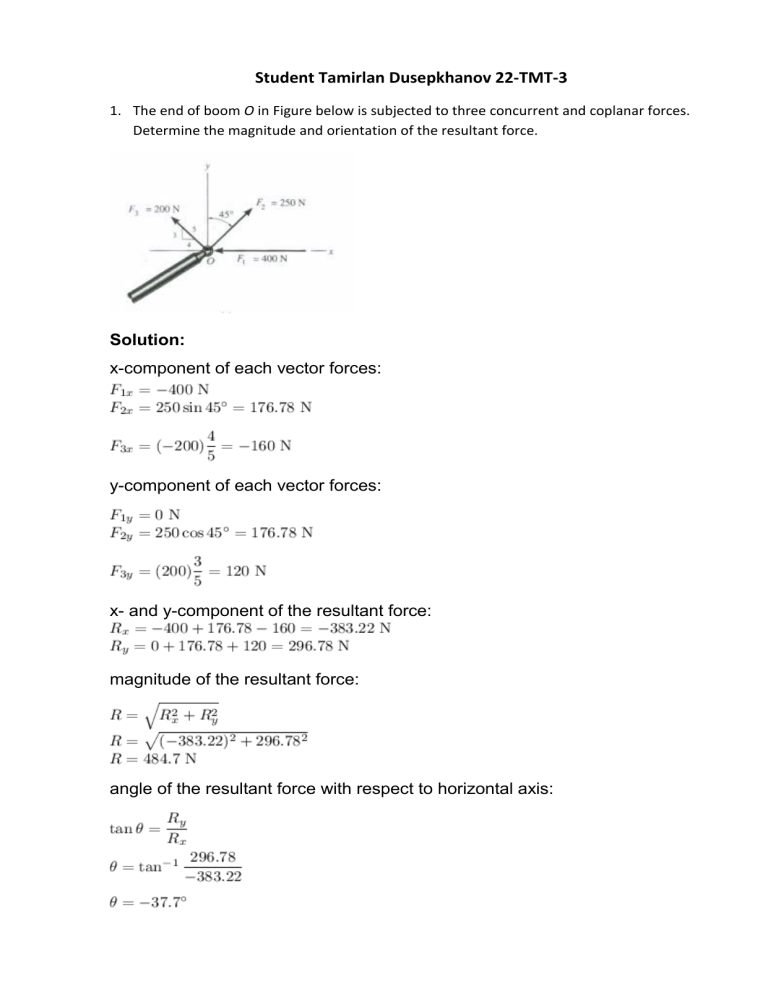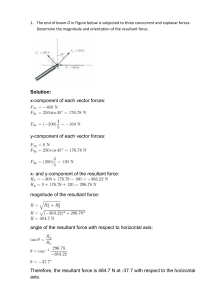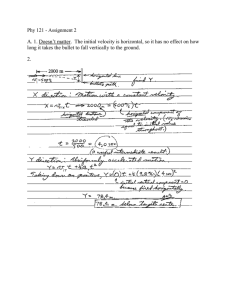
Student Tamirlan Dusepkhanov 22-ТМТ-3 1. The end of boom O in Figure below is subjected to three concurrent and coplanar forces. Determine the magnitude and orientation of the resultant force. Solution: x-component of each vector forces: y-component of each vector forces: x- and y-component of the resultant force: magnitude of the resultant force: angle of the resultant force with respect to horizontal axis: Therefore, the resultant force is 484.7 N at -37.7 with respect to the horizontal axis. 2. During a test, the car moves in a straight line such that for a short time its velocity is defined 2 by v (9t 2t ) m/s, where t is in seconds. Determine its position and acceleration when t = 3 s. When t = 0, s = 0. To find The position and acceleration when t = 3 sec. taking 𝑎𝑡𝜏 = 0𝑠, 𝑥 = 0𝑚 We know that𝑢 = 𝑑𝑥 𝑑𝑡 𝑎𝑛𝑑 𝑎 = 𝑑𝑢 𝑑𝑡 Sox=∫ 𝑢𝑑𝑡 𝑥 = ∫ 0.3(9𝑡 2 + 2𝑡)𝑑𝑡 = 0.3(3𝑡 3 + 𝑡 2 ) + 𝑐 Given initial condition as t=0s, x=0m so c=0 𝑥(𝑡 = 3𝑠) = 0.3(81 + 9) = 27𝑚 Similarly 𝑑𝑣 𝑑(0.3(9𝑡 2 + 2𝑡)) 𝑎= = = (5.4𝑡 + 0.6)𝑚/𝑠 2 𝑑𝑡 𝑑𝑡 𝑎(𝑡 = 3𝑠) = (5.4(3) + 0.6)𝑚/𝑠 2 = 16.8𝑚/𝑠 2 Answer: The position and acceleration when t = 3 sec are 27m and 16.8m/s2 respectively. 2 3. A particle moves along a horizontal path such that its velocity is given by v (3t 6t ) m/s, where t is the time in seconds. If it is initially located at the origin O, determine the distance travelled by the particle during the time interval t = 0 to t = 3.5 s, and the particle’s average velocity and speed during this time interval. For t<2 s, velocity is negative. At t=2 s, velocity is zero and for t=2 s velocity is positive. 15 𝑠1 = ∫ 𝑢𝑑𝑡 0 1𝑠 = ∫ (3𝑡 2 − 6𝑡)𝑑𝑡 = 6.125𝑚 = 𝑑𝑖𝑠𝑝𝑙𝑎𝑐𝑒𝑚𝑒𝑛𝑡 𝑢𝑝𝑡𝑜 3.5 𝑠𝑠2 0 2 2 = ∫ 𝑢𝑑𝑡 = ∫ 0 0 2 3(𝑡 − 6𝑡)𝑑𝑡 = −4𝑚 𝑑𝑖𝑠𝑝𝑙𝑎𝑐𝑒𝑚𝑒𝑛𝑡 𝑢𝑝𝑡𝑜 2𝑠 d= distance travelled in 3.5s = 4+4+6.125=14.125m Average speed = 𝑑 14.125 𝑡 = 3.5 𝑚 𝑠1 𝑠 𝑡 = 4.03 𝐴𝑣𝑒𝑟𝑎𝑔𝑒 𝑣𝑒𝑙𝑜𝑐𝑖𝑡𝑦 = = 6.125 3.5 = 1.75𝑚/𝑠 4. The motorcyclist attempts to jump over a series of cars and trucks and land smoothly on the other ramp, i.e., such that his velocity is tangent to the ramp at B. Determine the launch speed vA necessary to make the jump. vA=16.83 m/c 5. The boy throws a snowball such that it strikes the wall of the building at the maximum height of its trajectory. If it takes t = 1.5 s to travel from A to B, determine the velocity v A at which it was thrown, the angle of release θ, and the height h. vA = 49.8 ft/s, = 76.0E, h = 39.7 ft 6. The link in Figure below is subjected to two forces F1 and F2. Determine the magnitude and orientation of the resultant force. Ans: 629 N, 67.9° ccw from x-axis




